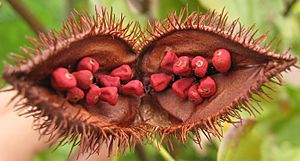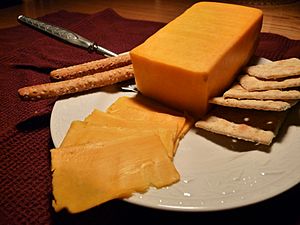Annatto facts for kids
Quick facts for kids Annatto |
|
|---|---|
 |
|
| Open fruit of the achiote tree (Bixa orellana), showing the seeds from which annatto is extracted. | |
| Scientific classification | |
| Genus: |
Bixa
|
| Species: |
orellana
|
Annatto is a special orange-red spice and food coloring. It comes from the seeds of the achiote tree, which grows in warm, tropical places from Mexico to Brazil. People often use annatto to make foods look yellow or orange. Sometimes, they also use it for its unique taste and smell. Its smell is a bit like pepper with a hint of nutmeg. Its taste is described as slightly nutty, sweet, and peppery.
The bright color of annatto comes from natural colors called carotenoid pigments. The main ones are bixin and norbixin, found in the reddish coating around the seeds. To make annatto, people usually grind the seeds into a powder or a paste. You can also get the color and flavor by soaking the seeds in hot water, oil, or lard. Then, this colored liquid or oil is added to food.
Today, annatto and its extracts are used a lot, both by hand and in factories. They color many processed foods like cheeses, dairy spreads, butter, margarine, custards, cakes, and other baked goods. You can also find it in potatoes, snack foods, breakfast cereals, smoked fish, and sausages. Annatto is a natural choice instead of man-made food colorings. However, it has been linked to rare cases of allergies in some people. In the United States, annatto is very important because the Food and Drug Administration says it's a "natural" color that doesn't need special approval.
Contents
Annatto's History
The achiote tree, where annatto comes from, is thought to have started in the tropical areas between Mexico and Brazil. At first, people probably didn't use annatto just for food. They used it for other things like painting their bodies for rituals or decoration. Many native tribes in Brazil, like the Wari', still do this today. It was also used as sunscreen and to keep insects away. Plus, it had some medical uses. In the 1500s, it was even used to color old Mexican books and writings.
Annatto has been a traditional coloring and flavoring in Latin America, the Caribbean, and the Philippines. Spanish and Portuguese explorers brought it to these places in the 1500s. It has different local names depending on the region. Over time, its use spread to other parts of the world. It became a part of the cooking traditions in many countries outside the Americas.
Annatto in Cooking
Traditional Dishes
Ground annatto seeds are often mixed with other spices. They are used as a paste or powder in cooking, especially in Latin American, Jamaican, Belizean, Chamorro, Vietnamese, and Filipino cuisines. In Mexican and Belizean cuisines, it helps make a spice mix called recado rojo. In Venezuela, annatto is used in dishes like hallacas and huevos pericos.
In Puerto Rico, annatto is often cooked with lard or olive oil to make annatto-oil. It's also ground with other spices to make sazón. This is used in many dishes like Pasteles, arroz con gandules, and arroz junto. Annatto paste is a key part of cochinita pibil, a slow-roasted pork dish popular in Mexico. It's also important for the drink tascalate from Chiapas, Mexico. In the Philippines, it colors the sauce for pancit. In Guam, it's used to make a main rice dish flavored with annatto, onion, garlic, and butter.
Coloring Processed Foods

Annatto is widely used today to give a yellow or orange color to many foods made in factories. This includes cheese, ice cream, baked goods, desserts, fruit fillings, yogurt, drinks, butter, oils, margarines, and processed cheese. In Europe, it's known as E160b.
Why Cheese is Colored
The natural yellow and orange colors in cheese used to change throughout the year. This happened because of what cows ate. In summer, with fresh grass, milk had more natural carotene. This made the cheese a natural orange color. At other times, the color would be much lighter. Also, if farmers skimmed the cream from the milk to make butter, the cheese made from that milk would be white and seen as lower quality.
To make all cheese look like the best summer cheese, cheesemakers started adding colors. At first, they used things like saffron, marigold, and carrot juice. Later, annatto became popular.
In the 1600s, Dutch traders bought annatto from native groups in Guyana and Suriname. They sold it in the Netherlands. The first known record of annatto being used in cheese is from a Dutch book in 1743. Other old papers from that time confirm that annatto was used to color cheese by the mid-1700s.
England also started using annatto to color its cheeses. As early as the 1500s, colors were added to Gloucester cheese. This helped make regular cheese look like the famous Double Gloucester. Annatto was later used for this. This practice spread to other parts of the UK for cheeses like Cheshire and Red Leicester. It was also used for colored Cheddar made in Scotland. Many Cheddar cheeses come in both white and orange types. The orange one is more popular, even though the only difference is the annatto color. This idea has spread to many modern processed cheese products, like American cheese and Velveeta. Cheeses from other countries also use annatto, such as Mimolette from France and Leyden from the Netherlands.
Cheeses that often use annatto include:
- Cheddar (UK)
- Cheshire (UK)
- Colby (U.S.)
- Gloucester (UK)
- Graskaas (Netherlands)
- Leyden (Netherlands)
- Livarot (France)
- Mimolette (France)
- Mont des Cats (France)
- Muenster (U.S.)
- Red Leicester (UK)
- Saint Paulin (France)
- Shropshire Blue (UK)
Annatto's Chemistry
The yellow to orange color in annatto comes from chemicals called bixin and norbixin. These are types of carotenoids. The color in the raw annatto extract is called bixin, which dissolves in fat. This bixin can then be changed into norbixin, which dissolves in water. It's rare for a carotenoid to dissolve in both fat and water. Annatto seeds have about 4.5–5.5% pigment, and 70–80% of that is bixin. Unlike beta-carotene, another well-known carotenoid, annatto colors do not turn into vitamin A in your body. If an annatto color has more norbixin, it will be more yellow. If it has more bixin, it will be more orange.
Is Annatto Safe?
In the United States, annatto extract is considered a safe color additive. It is seen as a natural coloring. Foods colored with annatto can say "colored with annatto" or "annatto color" on their ingredient list.
Annatto spices and colors are safe for most people when used in normal food amounts. However, they might cause allergic reactions in some sensitive people. In one study from 1978, 61 patients with skin rashes or swelling were given annatto extract. About 26% of these patients reacted to the color within four hours. This was a higher reaction rate than some man-made dyes.
Annatto is not one of the "Big Eight" foods that cause most allergic reactions. These eight are cow's milk, egg, peanuts, tree nuts, fish, shellfish, soy, and wheat. These eight foods cause over 90% of food reactions. The Food and Drug Administration and experts at the Food Allergy Research and Resource Program (FARRP) do not include annatto on their list of major food allergens.
Images for kids
See also
 In Spanish: Achiote (pigmento) para niños
In Spanish: Achiote (pigmento) para niños



